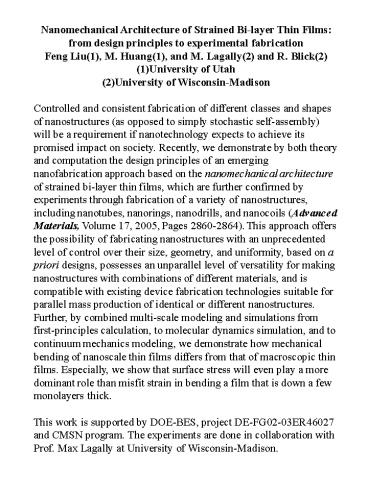Nanomechanical Architecture of Strained Bi-layer Thin Films: - PowerPoint PPT Presentation
1 / 2
Title:
Nanomechanical Architecture of Strained Bi-layer Thin Films:
Description:
Controlled and consistent fabrication of different classes and shapes of ... the design principles of an emerging nanofabrication approach based on the ... – PowerPoint PPT presentation
Number of Views:35
Avg rating:3.0/5.0
Title: Nanomechanical Architecture of Strained Bi-layer Thin Films:
1
- Nanomechanical Architecture of Strained Bi-layer
Thin Films - from design principles to experimental
fabrication - Feng Liu(1), M. Huang(1), and M. Lagally(2) and
R. Blick(2) - University of Utah
- University of Wisconsin-Madison
- Controlled and consistent fabrication of
different classes and shapes of nanostructures
(as opposed to simply stochastic self-assembly)
will be a requirement if nanotechnology expects
to achieve its promised impact on society.
Recently, we demonstrate by both theory and
computation the design principles of an emerging
nanofabrication approach based on the
nanomechanical architecture of strained bi-layer
thin films, which are further confirmed by
experiments through fabrication of a variety of
nanostructures, including nanotubes, nanorings,
nanodrills, and nanocoils (Advanced Materials,
Volume 17, 2005, Pages 2860-2864). This approach
offers the possibility of fabricating
nanostructures with an unprecedented level of
control over their size, geometry, and
uniformity, based on a priori designs, possesses
an unparallel level of versatility for making
nanostructures with combinations of different
materials, and is compatible with existing device
fabrication technologies suitable for parallel
mass production of identical or different
nanostructures. Further, by combined multi-scale
modeling and simulations from first-principles
calculation, to molecular dynamics simulation,
and to continuum mechanics modeling, we
demonstrate how mechanical bending of nanoscale
thin films differs from that of macroscopic thin
films. Especially, we show that surface stress
will even play a more dominant role than misfit
strain in bending a film that is down a few
monolayers thick. - This work is supported by DOE-BES, project
DE-FG02-03ER46027 and CMSN program. The
experiments are done in collaboration with - Prof. Max Lagally at University of
Wisconsin-Madison.
2
Fig. 1. Schematic illustration of a strained
bi-layer film folding into a nanotube when its
width W is large, but into a coil when its width
W is small, demonstrating the design principles
of nanomechanical architecture of strained
bi-layer films. The arrows indicate the folding
direction. There exist two critical geometric
conditions for coil formation W lt L0 2pR0,
where R0 is the characteristic radius of bending
curvature, and q gt qc sin-1(L/W0). The spiral
angle of the coil depends on the folding
direction as a tan-1(d/R0), with the smallest
spiral angle of q tan-1(W/R0).
Fig. 2. SEM image of nanoarchitectures fabricated
from strained Si/SiGe bi-layer films. (a)
Nanorings with a thickness of 80 nm, radius of
3.0 mm, and width of 3 mm (b) nanodrill with
a thickness of 110 nm, radius of 2.4 mm, and
width of 10 mm and (c) Nanocoil with a thickness
of 110 nm, radius of 2.4 mm, and width of 2 mm.
In general, we can vary the thickness from 10 nm
to 200 nm and dimensions from 20 nm to 100 mm.































